
Cherokee Clans
Encyclopedia
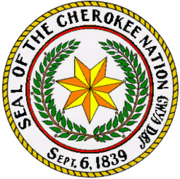
Cherokee
The Cherokee are a Native American people historically settled in the Southeastern United States . Linguistically, they are part of the Iroquoian language family...
society. They are hereditary and matrilineal.
The seven clans
Cherokees have seven clans, although some have multiple names and could be combinations of several previous clans.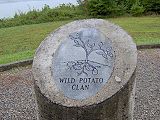
Ani-gatagewi
"Ani-gatagewi" cannot confidently be translated, according to James MooneyJames Mooney
James Mooney was an American ethnographer who lived for several years among the Cherokee. He did major studies of Southeastern Indians, as well as those on the Great Plains...
; however, this clan is known as the "Wild Potato Clan", or occasionally as the "Blind Savannah Clan."
The Anigotegewi or the Wild Potato Clan's subdivision is Blind Savannah. Historically, members of this clan were known to be 'keepers of the land,' and gatherers The wild potato was a main staple of the older Cherokee life back east (Tsalagi Uweti). At some Oklahoma Cherokee ceremonial grounds, the Wild Potato arbor is to the left of the Wolf arbor.
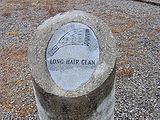
Ani-gilohi
This clan is translated as "Long Hairs" or "Twisters." According to the Cherokee authors Jack and Anna Gritts Kilpatrick, the name translates to "They have just become offended." According to Mooney, Gilahi is short for an old in fact very old ancient Gitlvgvnahita, the warrior women's society, meaning "something that grows from the back of the neck."The Anigilohi or the Long Hair Clan, whose subdivisions are Twister, Wind and Strangers, are regarded as peacemakers and Peace Chiefs would often be from this clan. In the times of the Peace Chief and War Chief government, the Peace Chief would come from this clan. Prisoners of war, orphans of other tribes, and others with no Cherokee tribe were often adopted into this clan, thus a common interpretation of the name 'Strangers.' At some Oklahoma Cherokee ceremonial grounds, the Long Hair arbor is on the East side, and also houses the Chiefs and other leaders of the ground.
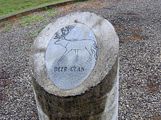
Ani-kawi
This is the "Deer Clan." Awi means "deer"; the "k" is added to separate the vowels. The Anikawi or the Deer Clan were historically known as fast runners and hunters. Even though they hunted game for subsistence, they respected and cared for the animals while they were living amongst them. They were also known as messengers on an earthly level, delivering messengers from village to village, or person to person. At some Oklahoma Cherokee ceremonial grounds, the Deer arbor is to the left of the Wild Potato arbor.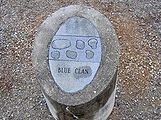
Ani-sahoni
This is the "Blue Clan" or "Clan of a Large Extinct Feline", according to Robert ConleyRobert Conley
Robert Conley is an American newspaper, television and radio reporter.- Overview :Foreign correspondent for The New York Times in the 1950s and 1960s, bureau chief for NBC News, Africa, as well as foreign correspondent for NBC News' The Huntley-Brinkley Report throughout the 1960s, editor for and...
. The Anisahoni or the Blue Clan subdivisions are Panther, or Wildcat and Bear. Historically, this clan produced many people who were able to make special medicines for the children. At some Oklahoma Cherokee ceremonial grounds, the Blue arbor is to the left of the Long Hair arbor.
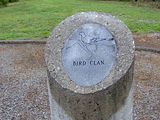
Ani-tsiskwa
This is the "Bird Clan". "Bird" is also transliterated in Cherokee as "jisqua". Anitsisqua or the Bird Clan were historically known as messengers. The belief that birds are messengers between earth and heaven, or the People and Creator, gave the members of this clan the responsibility of caring for the birds. The subdivisions are Raven, Turtle Dove and Eagle. Our earned Eagle feathers were originally presented by the members of this clan, as they were the only ones able to collect them. At some Oklahoma Cherokee ceremonial grounds, the Bird arbor is to the left of the Deer arbor.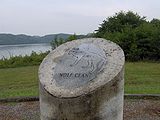
Ani-waya
This is the "Wolf Clan". The Aniwaya of the Wolf has been known throughout time to be the largest clan. During the time of the Peace Chief and War Chief government setting, the War Chief would come from this clan. Wolves are known as protectors. At some Oklahoma Cherokee ceremonial grounds, the Wolf arbor is to the left of the Blue arbor.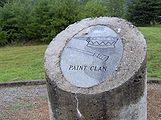
Ani-wodi
This is the "Paint Clan", also commonly called the "Red Paint Clan". The Aniwodi or the Paint Clan were historically known as a prominent medicine people. Medicine is often 'painted' on a patient after harvesting, mixing and performing other aspects of the ceremony. At some Oklahoma Cherokee ceremonial grounds, the Paint arbor is to the left of the Bird arbor.Customs of the Cherokee clans
Customs of the Cherokee clans have evolved since ancient times, however, traditionalists still observe clan customs regarding marriage and certain social events. In modern OklahomaOklahoma
Oklahoma is a state located in the South Central region of the United States of America. With an estimated 3,751,351 residents as of the 2010 census and a land area of 68,667 square miles , Oklahoma is the 28th most populous and 20th-largest state...
Cherokee culture, Stomp Dance
Stomp Dance
The Stomp Dance is performed by various Eastern Woodland tribes and Native American communities, including the Muscogee, Yuchi, Cherokee, Chickasaw, Choctaw, Delaware, Miami, Caddo, Ottawa, Peoria, Shawnee, Seminole, Natchez, and Seneca-Cayuga tribes...
s still observe clans for Stomp Dance events. Kituwah grounds have seven arbors around the dance circle, and each clan has their own arbor.
The Cherokee society is historically a matrilineal
Matrilineality
Matrilineality is a system in which descent is traced through the mother and maternal ancestors. Matrilineality is also a societal system in which one belongs to one's matriline or mother's lineage, which can involve the inheritance of property and/or titles.A matriline is a line of descent from a...
society; meaning clanship is attained through the mother. Traditionally, women are considered the head of household among the Western Cherokee in Oklahoma, with the home and children belonging to her should she separate from a husband. The knowledge of a person's clan is important for many reasons; historically, and still today among Cherokee traditionalists, it is forbidden to marry within one's clan. Clan members are considered brother and sisters. In addition, when seeking spiritual guidance and traditional medicine ceremonies, it is necessary to name one's clan. Seating at ceremonial stomp dances is by clan, as well. Conversely, allowing strangers to know your clan makes you vulnerable to potential attacks.
Cherokees born outside of a clan or outsiders who were taken into the tribe in ancient times had to be adopted into a clan by a clan mother. If the person was a woman who had borne a Cherokee child and was married to a Cherokee man, she could be taken into a new clan, and her husband was required to leave his clan and live with her in her new clan. Men who were not Cherokee and married into a Cherokee household had to be adopted into a clan by a clan mother, he could not take his wife’s clan.
In The Cherokee Editor on February 18, 1829, Elias Boudinot wrote the following regarding Cherokee Clan marriage customs:
- "This simple division of the Cherokees formed the grand work by which marriages were regulated, and murder punished. A Cherokee could marry into any of the clans except two, that to which his father belongs, for all of that clan are his fathers and aunts and that to which his mother belongs, for all of that clan are his brothers and sisters, a child invariably inheriting the clan of his mother."

